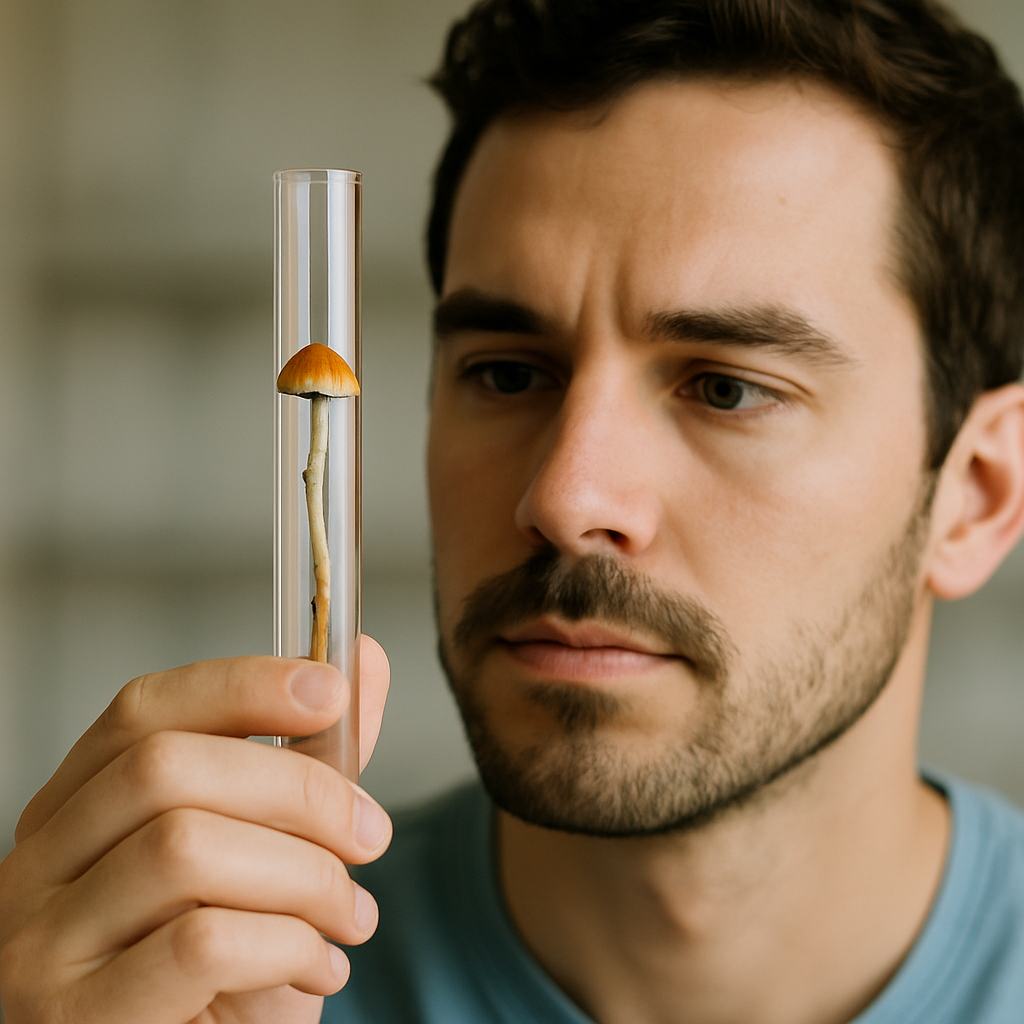Comparing Microdosing Protocols: Stamets Stack vs. Fadiman Method

If you’re exploring microdosing mushrooms for personal growth, you’ve likely come across two leading protocols: the Stamets Stack vs Fadiman Method. Both approaches offer structured microdosing protocols for taking sub-perceptual doses of psilocybin (the active compound in magic mushrooms), but they differ in schedule and philosophy. James Fadiman’s protocol is considered the classic introduction to microdosing, while Paul Stamets’ Stack is a newer regimen that adds a twist – literally “stacking” mushrooms with other supplements.
In this guide, we’ll compare the Fadiman microdosing method and the Stamets Stack in detail. We’ll break down their dosing schedules, the role of added supplements like Lion’s Mane, and what science (and anecdotal reports) say about each. By the end, you’ll have a clear picture of these microdosing protocols, delivered with our West-Coast good vibes and a data-driven lens.

The Fadiman Microdosing Method (One Day On, Two Days Off)
Dr. James Fadiman is often called the “father of modern microdosing” for popularizing this practice. His approach, introduced in The Psychedelic Explorer’s Guide, is a gentle protocol designed to integrate microdoses into ordinary life without building tolerance. The Fadiman Protocol can be summarized simply as: Dose → Rest → Rest → Repeat.
- Schedule: Take one microdose on Day 1, then do not dose on Days 2 and 3. These two days off allow any subtle effects (sometimes called an “afterglow”) to subside and help prevent your body from adapting (so the psilocybin stays effective). On Day 4, you dose again, repeating a cycle of dose, then two days off.
- Dosage: A typical psilocybin microdose is about 0.1–0.3 grams of dried magic mushrooms (around 1/10 to 1/20 of a full recreational dose). Fadiman’s method doesn’t specify an exact amount for everyone – the idea is to use a light dose that is sub-perceptual. In Canada, that might be a 100–250 mg mushroom capsule. For instance, our Elevate microdose capsules (each containing 200 mg of Golden Teacher mushrooms) could fit well within this range, allowing users to follow the Fadiman schedule with a consistent dose each time.
- Philosophy: Fadiman’s approach is all about balance and observation. You journal your experience, note subtle changes on dose days and off days, and adjust if needed.
- Experience: Many people choose the Fadiman method as their first microdosing regimen because it’s easy to remember (dose, skip, skip, repeat) and has a built-in check on frequency. Users often report on Day 1 (dose day) they might feel a slight uptick in focus or mood, Day 2 they feel lingering “afterglow” effects, and Day 3 they feel back to baseline – which helps in evaluating how microdosing affects them. By spacing out doses, it minimizes any risk of tolerance buildup. In practical terms, you can fit this into a routine – e.g. dose on a workday and again on the same day of the week, which is appealing to those with busy schedules who still want microdosing benefits.
- Science & Considerations: Because this method doesn’t involve any additional supplements, it’s straightforward to evaluate. Researchers have used similar schedules in observational studies of microdosers. Overall, some studies suggest that microdosing on a regimen like Fadiman’s can lead to self-reported improvements in mood, creativity, and mental health over several weeks. However, as a data-driven note, placebo-controlled trials are still ongoing. Fadiman’s protocol makes it easier to include “control” days for comparison, which is perhaps one reason scientists find it interesting. Ethically, Fadiman emphasizes safety – if any negative effects arise, you stop or adjust.
In short, the Fadiman Method is a conservative, well-trodden path. It’s ideal if you want structure but also regular breaks. Think of it as a steady hiking rhythm: walk one day, rest for two, then continue, allowing time to reflect on the journey.

The Stamets Stack Protocol (Four or Five Days On, Two or Three Off + Supplements)
On the other side of the microdosing spectrum, we have the Stamets Stack. This protocol is named after Paul Stamets, a legendary mycologist from the U.S. West Coast who brought a biohacker’s flair to microdosing. Stamets didn’t just propose a schedule – he suggested “stacking” psilocybin with Lion’s Mane mushroom and niacin (vitamin B3) to potentially amplify neurogenic and cognitive benefits. Stamets’ idea is growth-minded and innovative: combining a psychedelic (psilocybin) with functional mushrooms and a vitamin to create a synergistic effect on the brain.
- Schedule: The Stamets Stack is commonly implemented as microdosing for several days in a row, then taking a few days off. Stamets originally described a 4 days on, 3 days off cycle. A popular adaptation is dosing on weekdays (5 days on) and resting on weekends (2 days off), which fits neatly into a workweek. Either way, you are microdosing more frequently than in Fadiman’s approach – essentially daily on those on-days. For example, you might microdose Monday through Thursday, then pause Friday through Sunday. The rationale is to saturate your system for a short period to potentially promote neuroplasticity, then pause to reset tolerance.
- Dosage & Stack Components: A Stamets Stack microdose of psilocybin is similar in size to Fadiman’s (e.g. ~0.1g to 0.2g dried mushrooms per dose), but each dose is paired with Lion’s Mane (a medicinal mushroom known for cognitive support) and niacin (vitamin B3). Lion’s Mane is believed to have nerve-growth stimulating properties, and niacin in high doses causes a flush that Stamets theorized might help carry these compounds to the brain. A typical “stack” dose might look like: 100 mg of psilocybin + 500 mg of Lion’s Mane + 50 mg of niacin, taken together. In fact, we offer a product that embodies this philosophy – Regenerate microdose capsules – which contain Golden Teacher mushroom (psilocybin) along with Lion’s Mane extract and a touch of niacin, all in one capsule. This kind of product conveniently gives you the full Stamets Stack in a measured dose, aligning with Stamets’ patented formula.
- Philosophy: The Stamets protocol is rooted in a belief in synergy and biohacking spirit. Stamets, being a scientist at heart, hypothesized that combining these natural substances could “stack” the benefits – potentially enhancing neurogenesis (brain cell growth) and cognitive function beyond what psilocybin alone might do. It’s an experimental, data-driven approach that appeals to those who love to optimize and innovate. At the same time, it carries a West-Coast vibe of embracing natural nootropics: psilocybin for mindset, Lion’s Mane for focus, niacin for circulation – all organic, earth-derived ingredients.
- Experience: Following the Stamets Stack means committing to near-daily dosing for a short cycle. Many users report that during the on-days, they feel a consistent subtle boost – as if they are “in the flow” for several days straight. Lion’s Mane itself is non-psychoactive but reputed to aid memory and clarity; some folks say the combo makes their microdosing days feel like they’re firing on all cylinders. The niacin flush (a warming, reddening sensation) can be a surprise for first-timers – it’s harmless and passes, but it definitely reminds you you’ve taken your stack! After four or five days of dosing, you then consciously stop and take the rest days. These off-days are important: they’re when your receptors reset. Users might actually feel a bit of fatigue or return to baseline during the break (some even miss the stack’s effects on off-days, which is why responsibly sticking to the off-days is crucial to avoid building tolerance or psychological dependency).
- Science & Considerations: The Stamets Stack is intriguing, but what does the data say? Research on combined stacking is still in early stages. One large observational study in 2022 found that after 30 days of microdosing (participants largely using Stamets-type stacks or similar), there were small-to-medium improvements in mood and mental health compared to non-microdosing controls. Notably – and perhaps contrary to Stamets’ hypotheses – the study reported no significant additional mood benefit from adding Lion’s Mane and niacin to psilocybin, except in one area: older adults who stacked did show improved psychomotor performance (like coordination) compared to those who took psilocybin alone. In plain terms, the Lion’s Mane + B3 didn’t make people happier than psilocybin by itself in that 30-day window, but it might have helped with certain cognitive/motor functions, especially in older microdosers.
What does this mean for someone considering the Stamets Stack? It tells us that the evidence is mixed on the additive effect – you might not get dramatically different mood results with the extras, but there could be other subtle benefits. However, many microdosing enthusiasts still swear by the stack, citing personal gains in creativity or mental clarity. Importantly, Stamets also recommends doing his cycle for no more than a month or so before taking a longer break (e.g. take 2-4 weeks off after a few cycles) to ensure you don’t develop tolerance.
In summary, the Stamets Stack is the “all-in” microdose protocol: more frequent dosing and more ingredients. It’s suited for people who are perhaps a bit more experienced or are keen on nootropic supplements and don’t mind a stricter routine (taking something every day for several days). Just remember, even adventure-seekers need to know when to pause – those off-days are part of the plan to keep it safe and sustainable.

Which Microdosing Protocol is Right for You?
Selecting Stamets vs Fadiman ultimately comes down to your goals, lifestyle, and how your body responds. Here are a few considerations to help you choose your path:
- If you are new to microdosing: Many recommend starting with the Fadiman protocol. Its slower pace lets you gently trial microdosing without overwhelming yourself. You can gauge how you feel on dose days versus off days, and it’s easier to pinpoint any changes.
- If you want a simpler routine or are very sensitive: Fadiman’s one-every-three-days is easy to follow and leaves plenty of recovery time.
- If you’re looking for enhanced cognitive support and don’t mind complexity: The Stamets Stack could be appealing. For someone already taking their Lion’s Mane coffee in the morning and a B3 vitamin, adding a microdose to that mix may feel natural. The Stamets approach might align if you’re trying to target not just mood, but potentially memory, learning, or “neurohack” your brain.
The good news is that these protocols aren’t mutually exclusive or irrevocable choices. Some users actually try both at different times. You could start with Fadiman for a month, take a break, then attempt a Stamets cycle and compare how you feel. Remember to change only one variable at a time so you can clearly tell the differences.

Explore Your Path Responsibly
Microdosing, whether via the Fadiman protocol or the Stamets Stack, represents a new frontier in personal wellness – a blend of ancient mushroom wisdom and modern, mindful practice. Canada’s west-coast microdosing community has embraced both approaches, embodying that spirit of adventure with care. By comparing Stamets Stack vs Fadiman Method, we see there’s no one-size-fits-all answer. The best microdosing protocol is the one that fits you – your lifestyle, your biochemistry, and your personal development goals.
Ready to take the next step? If you’re interested in exploring microdose-friendly products, check out our curated selection of organic mushroom capsules and more at PathSupply.ca.
Happy microdosing, and stay safe out there!

